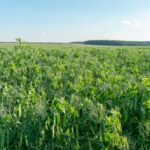In modern agriculture, the combine harvester is one of the most important machines, playing a crucial role in maximizing harvest efficiency. This versatile piece of equipment integrates multiple harvesting processes into a single operation, making it possible to harvest crops more quickly and effectively than traditional methods. By understanding the role of a combine harvester, farmers can leverage its capabilities to boost productivity, reduce labor costs, and ensure a higher quality harvest.
What is a Combine Harvester?
A combine harvester is a large agricultural machine designed to efficiently harvest a variety of crops, such as wheat, corn, barley, and soybeans. The word “combine” refers to the fact that this machine combines several harvesting functions—reaping, threshing, and winnowing—into a single process. This reduces the need for multiple pieces of equipment and allows farmers to harvest large areas of crops in a relatively short period of time.
Key Functions of a Combine Harvester
- Reaping (Cutting the Crop) The first step in the harvesting process is reaping, where the combine harvester uses a cutter bar or header to cut the crop at the base. This mechanism ensures that the crop is harvested at the optimal height, preventing damage to the plant and ensuring that the entire crop is collected.
- Threshing (Separation of Grain from the Plant) After the crop is cut, it enters the threshing system of the combine harvester. The threshing drum, often accompanied by concaves, separates the grain from the stalks and other plant material. This process is essential for ensuring that only the edible part of the crop, such as the seeds or kernels, is collected, while the straw and other debris are left behind.
- Winnowing (Separation of Grain from Chaff) Winnowing involves the removal of lighter plant material, such as chaff and husks, from the grain. A fan or air system inside the combine blows away the unwanted debris, leaving only clean grain. This ensures the harvested product is free of impurities and ready for storage or further processing.
- Grain Collection and Storage Once the grain is separated and cleaned, it is stored in a hopper or grain tank located on the combine. This tank holds the harvested grain until it can be offloaded into a trailer or grain bin. The capacity of the grain tank plays a significant role in minimizing downtime, as a larger tank means fewer stops to unload the grain, allowing for continuous operation.
- Straw Management In addition to collecting grain, modern combine harvesters often have the capability to manage the leftover straw. Some combines are equipped with straw walkers or choppers that cut and distribute the straw across the field, returning valuable organic matter to the soil. This process can improve soil fertility and reduce the need for additional fertilization.
How Combine Harvesters Maximize Harvest Efficiency
- Speed and Labor Reduction One of the primary benefits of a combine harvester is its speed. A single combine harvester can cover vast areas of farmland in a short amount of time. This significantly reduces the number of workers required for the harvesting process, lowering labor costs and minimizing human error. With their ability to work efficiently, combines can often harvest more land in one day than traditional methods could accomplish in several days.
- Improved Crop Quality Combine harvesters are designed to cut and process crops with minimal damage. The precision of the cutting mechanism, coupled with the threshing and winnowing systems, ensures that the grain is harvested without excessive breakage or contamination. This leads to higher-quality crops, which can fetch better prices at market. Additionally, the machine’s ability to harvest crops at the optimal stage of ripeness further improves quality.
- Fuel and Resource Efficiency Modern combine harvesters are engineered for fuel efficiency, allowing farmers to get the most out of their fuel expenditure. By integrating multiple functions into one machine, the combine harvester reduces the need for additional machinery, such as separate threshers, balers, or grain carts. This not only saves fuel but also reduces wear and tear on other equipment, leading to long-term cost savings.
- Advanced Technology for Precision Farming Today’s combine harvesters come equipped with cutting-edge technology such as GPS, yield mapping, and auto-steering systems. These features enable farmers to track yield data in real time, optimize field coverage, and ensure that crops are harvested uniformly. GPS-guided systems help reduce overlaps, improving efficiency by ensuring that every part of the field is harvested without wasting resources. Yield mapping provides valuable insights into field productivity, allowing farmers to make informed decisions for future planting and fertilization.
- Minimal Crop Loss The combine harvester’s ability to efficiently separate grain from the plant with minimal loss is one of its standout features. By ensuring that almost all of the harvested crop is collected, combine harvesters reduce the amount of grain left behind in the field. This not only maximizes the yield but also minimizes waste and improves the overall profitability of the operation.
- Versatility in Different Field Conditions Modern combine harvesters are designed to work in various field conditions, from dry, well-drained soils to wet or uneven terrain. With adjustable settings for different crop types and field conditions, the combine harvester can be adapted to optimize performance, ensuring that farmers can harvest in challenging environments with ease.
The combine harvester is a cornerstone of modern agriculture, offering immense benefits in terms of efficiency, quality, and resource conservation. By integrating the processes of reaping, threshing, and winnowing into one machine, farmers can significantly increase their harvesting speed, reduce labor costs, and improve crop quality. With advancements in technology, these machines continue to evolve, providing farmers with the tools they need to maximize harvest efficiency and maintain a competitive edge in the global market. For any farming operation, investing in a combine harvester is a step toward more sustainable, profitable, and efficient agriculture.
Join 'Farmers Mag' WhatsApp Channel
Get the latest Farming news and tips delivered straight to your WhatsApp
CLICK HERE TO JOIN






